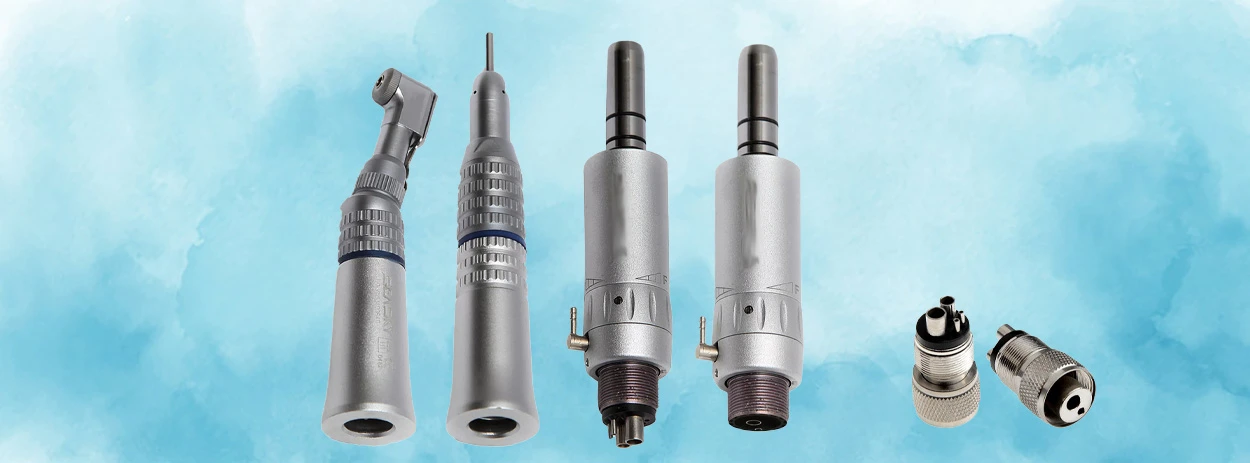When prioritizing critical tools in modern dental practice, dental handpieces consistently emerge as indispensable clinical assets. Beyond mere assistants, these precision instruments streamline operative workflows,directly enhancing treatment outcomes while advancing oral health management protocols. In this article, we will introduce dental handpieces to you in a comprehensive way.
1.What is a dental handpiece
Dental handpieces refer to a class of reusable and strictly sterilized precision instruments in the field of dentistry, which are mainly used for dental cutting, restoration, polishing and other operations. These instruments are usually made of metal materials (e.g. stainless steel, titanium alloy) and are designed as removable structures for thorough cleaning and sterilization.
2. What are the types of dental handpieces
There are many types of dental handpieces, categorized according to the three dimensions of driving principle, clinical function and rotational speed parameter. This article focuses on the analysis of rotational speed grading system in the clinical operation of the technical specifications:
- High-Speed Handpieces: rotational speed up to 300,000-400,000 rpm, used for rapid cutting of dental tissues (e.g. caries removal, tooth preparation)
- Low-Speed Handpieces: speeds usually below 20,000 rpm, used for fine grinding in conjunction with turning pins or prophy cups.
- Surgical Handpieces: used for dental implants or bone reshaping, requiring higher torque and sterilization safety.
| Dimensions | Types |
| Driving Principle | pneumatic/electric handpieces |
| Clinical Function | implant/endodontic/surgical handpieces |
| Rotational Speed Parameter | high speed/low speed handpieces |

3. Role of dental handpieces
High speed cutting:
- High-speed turbine handpiece: used for caries decay removal, dental body repair and root canal opening pulp, its high speed with diamond turning needle can accurately cut hard tissues, the error is controlled within 0.1mm.
- Contra-angle handpieces: Engineered for impacted molar extraction procedures.

Fine restoration and polishing:
- Low-speed contra-angle handpiece (20,000-50,000 rpm): Used for root canal preparation, gutta-percha points removal, and fiber post treatment. Its low-speed, high-torque characteristics (up to 3.5N·cm) ensure operational stability.
- Low-speed straight machine with prophy cup or prophy brush to complete the denture polishing and polishing, plaque removal, suitable for extra-oral restorations processing, fine polishing and beautification.
Implant and Surgical Operation
Implantology handpieces: Featuring a 20:1 gear ratio that generates enhanced torque output , enabling penetration through dense alveolar bone structures. This advantage supports bone contouring and osteotomy preparation procedures. With accelerated advancements in dental implantology, these devices have entered a pivotal phase in implant device innovation. Other dental surgical procedures, such as extractions, can be performed with low-speed surgical handpieces, and root canals, with endodontic handpieces. These types of dental handpieces are generally electrically driven and can provide high torque.
4. How to choose the right dental handpiece for your practice
- Sterilization compatibility: Confirm which sterilization methods can be supported by Handpieces, whether they support pre-vacuum autoclaving (Class B sterilization cycle) and chemical immersion sterilization, and try not to choose a model that only supports a single sterilization method.
- Speed and torque requirements: High-speed handpieces – prioritize models with speeds ≥ 300,000 rpm and with 4-hole cooling jets (to reduce thermal damage.) Low-speed handpieces – torque ≥ 2.2 Ncm. Do not choose low standard handpieces, they either have substandard material performance or too short a service life to be economically viable.
- Ergonomic design: weight <80g, grip diameter 28-32mm (in accordance with ISO 13485 ergonomic standards) to reduce operator hand fatigue.
- Brands and certifications: Choose brands that have passed FDA (U.S.) and CE (European Union) certifications.
5. The importance of dental handpieces in dental practice
Enabling precise control
Dental handpieces are easier to control with precision, allowing the dentist to perform very detailed operations in the mouth to achieve the desired treatment results.
Increase treatment efficiency
The high performance and versatility of dental handpieces makes the treatment process much shorter, and with the right combination of tools, the dentist can complete complex treatment tasks in a short period of time.
Improved treatment quality
Advanced handpiece systems elevate treatment precision and operational reliability through minimized procedural deviations. This constitutes a critical determinant in restorative dentistry, endodontic therapy, and precision-driven interventions requiring micron-level accuracy (ANSI/ADA Specification No. 35).
6. Dental handpiece maintenance and cost control
Dental handpieces generally have a long lifespan. In order to reduce long-term maintenance costs, preference is given to brands with universal parts. Bearings are an important part of dental handpieces and regular maintenance can extend their life.

Conclusion
Dental handpiece can make dental surgery high precision, high efficiency, high quality, is the core tool of modern dental diagnosis and treatment. It allows dental patients to complete their treatment quickly and comfortably. Please strictly follow the sterilization specifications, choose the appropriate performance model, and give full play to the maximum clinical value of dental handpieces.


